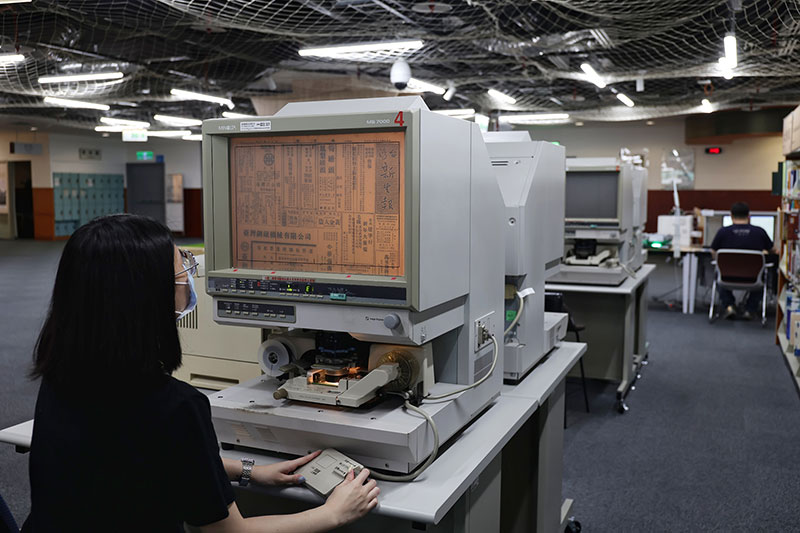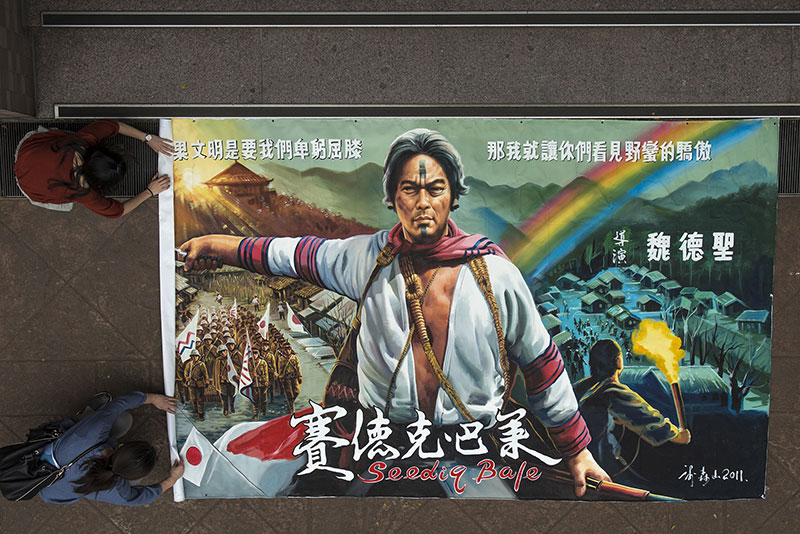
The National Taiwan Library has the largest collection of Japanese-era materials in the country. In 2007 the library began a program to digitize its collections.
When we flip through photo albums from our childhood days, the pictures call up memories both bitter and sweet. Those experiences shaped the people we have become. If we extend this notion back by 30, 50, or 100 years to images of the places where we and our families have lived, will we not find clues to the living conditions and historical events that our parents and grandparents experienced, and discover the elements that have molded the era in which we live today?
Thanks to modern technology, we can make digital collections of everything from old photos, old newspapers, and printed materials to maps and videos or films. Moreover, by attaching metadata, we can enable the content to be quickly accessed using keywords, or the data can be used as a guide to physical archives. In this way we can explore unfamiliar and forgotten aspects of the past, and steadily piece together historical truths.
Digital collections of Taiwanese history
If you visit the website or Facebook page of Old Taiwanese Photographs in Color (fb.com/oldtwcolor), created by GJ Taiwan, you will see many colorful photographs, such as photos of Taipei’s earliest public buses, which may make you want to learn more about the people who rode in the buses back then and the environment in which they lived; or images of vigorous military men on horseback escorting Japan’s Crown Prince Hirohito as he traveled in an open-topped horse-drawn carriage during his 12-day visit to Taiwan in 1923.
The vivid photographs on the website come from a digital collection of precious old black-and-white photos. Prince Wang, operator of the independent bookstore GJ Taiwan, consulted countless documents to confirm the colors of Taipei’s earliest public buses and of clothing and buildings in the era of Japanese colonial rule in Taiwan (1895–1945), and even interviewed people who lived in those days, before individually colorizing the images in hopes of restoring the elegant appearance of the past.
It is not only old photographs that can call up many precious memories; digital collections of videos can do so as well. For example, the website “UDN time” (time.udn.com), operated by the United Daily News Group, has videos and text offering comprehensive depictions of many important historical events. One of its videos describes how the Jiancheng Circle, once a major Taipei landmark, got its start as a traffic circle in the era of Japanese rule, evolved into a popular night market with food vendors, and finally became today’s public plaza with open green space where people can go and relax.
Meanwhile the Taiwan Diary Knowledge Bank (taco.ith.sinica.edu.tw/tdk), set up by the Academia Sinica’s Institute of Taiwan History, brings together the personal journals of a number of people who have had an influential role in Taiwan’s history. These not only offer insights into their views at the time and illustrate social change, they also reflect the ideas of the eras in which they lived. As personal diaries, they include many anecdotes that were not public knowledge at the time, giving later generations a more authentic and vivid image of the history they portray.

To facilitate archiving of newspapers, in the past they were photographed page by page in black and white and reduced to microfilm or microfiche.
Archiving native sources
The 1980s were a period of tremendous change in Taiwan, and the rise of “nativist” or “local” thinking that followed the lifting of martial law in 1987 drew greater attention to discussions of Taiwanese values. The nativist movement encouraged more people to learn about the land where they were born and raised, and “Taiwan studies” flourished in many fields including literature, fine arts, music, dance, and theater. Following Taiwan’s first-ever peaceful transition of power between political parties in 2000, the government began to actively promote research into Taiwanese culture and history, and such research became a major trend in academia, giving rise to a large demand for access to related materials. At the same time, libraries and academic institutions holding such materials began to digitize their collections with the help of government subsidies.
“The forerunner of the National Taiwan Library was the library set up in 1914 by the office of the Japanese governor-general, so the NTL holds the most information from the Japanese era. The library founded a Taiwan studies research center in 2007, and launched a digital archiving program with subsidies from the Ministry of Education. Over the years it has constructed all kinds of digital databases.” NTL staff member Tsai Hui-pin, who is a scholar of Taiwan history and author of popular history books, notes that a digital collection is created from physical objects and information that are considered worth preserving, using methods such as photography, scanning, video recording, and full text input to generate digital files that are stored with descriptive metadata attached. It requires a great deal of manpower and storage capacity, which is why libraries and other organizations have opted to bring in businesses that possess the relevant technology to build their databases. Firms such as Transmission Books & Microinfo (TBMC), TTS, and FlySheet have been working with libraries and other institutions to create digital collections.
Analyzing history with digital collections
Using digital collections as a research tool, one can focus on a subject as small as a single person or as large as rewriting history. For example, academic knowledge of Taiwan’s Aboriginal peoples started with the work of Japanese anthropologist Ryuzo Torii, who came to Taiwan many times in the colonial era to study them. He drew a broad distinction between plains and mountain Aborigines, and categorized the mountain Aborigines into nine tribes, including the Atayal, Saisiyat, and Bunun. This classification remained unchanged until after the establishment of the Council of Aboriginal Affairs (now the Council of Indigenous Peoples) in 1996. However, in recent years, with scholars examining evidence on the status of other groups, the number of recognized indigenous peoples has expanded to 16.
Another example is the Rover Incident of 1867, in which crew members from the wrecked US merchant ship Rover stumbled into the territory of the Paiwan indigenous people and were killed as invaders. Files from the US consulate in Xiamen (Amoy) held by the US National Archives as microform material and digitized by TBMC include the consulate’s official dispatches to the US Department of State from 1844 to 1906. The content covers many historical events including the abortive expedition to Taiwan by US admiral Henry H. Bell to punish the indigenous peoples for the death of the sailors from the Rover, the agreement reached between US consul Charles W. Le Gendre and Taiwan’s indigenous peoples on the rescue of shipwreck survivors, and the Japanese exploration and occupation of Taiwan. These digitized documents include a great deal of important historical data, offering an entirely new perspective on Taiwan’s history.
“Among digitized historical materials, in recent years old photographs have attracted the most attention. This is because much of the textual information surviving from the era of Japanese rule in Taiwan is written in Japanese, so it is not accessible to most people. Photographs, on the other hand, do not have this disadvantage.” Besides old photos, Tsai Hui-pin mentions the Taiwan Daily News. This newspaper, which had the largest circulation of any Taiwanese paper under Japanese rule, not only briefly published a Chinese-language edition, but the main paper had sections in both Japanese and Chinese. It reported on laws and regulations, current affairs, and societal phenomena, and its rich and diverse content means that it is widely used by scholars. However, it should be noted that newspapers have always been difficult to digitize because the paper is prone to becoming brittle and is hard to conserve, and it is an enormous project to digitize and index the wide variety of information on each page. These challenges further highlight the value of the Taiwan Daily News database constructed by TBMC.

The settings depicted in Wei Te-sheng’s film Seediq Bale: Warriors of the Rainbow (2011), about the Wushe Incident of 1930, were based on information gleaned from a great quantity of historical materials. (photo by Kent Chuang)
Making history accessible
Filmmaker Wei Te-sheng discovered an intriguing question while looking through Taiwanese historical materials: Why was there a baseball team in the era of Japanese rule composed of Han Chinese, indigenous people, and Japanese? The multiethnic team not only became the top squad in Taiwan, they made it to the final of Japan’s famed National High School Baseball Championship at the Koshien Stadium. Wei took this story and transformed it into the award-winning film Kano (2014). To faithfully recreate the sights and sounds of that era, he consulted digital archives and did much historical research, including field research and interviews with participants in the events of the time, before finally moving this inspiring story to the silver screen. He had previously made a movie about the Wushe Incident called Seediq Bale: Warriors of the Rainbow (2011). In these films, threads drawn out of historical materials were crafted into motion pictures that are highly accessible to ordinary people.
To turn dry historical data into works that people find interesting requires an interpreter with a background in history and skills in combing through data and in storytelling. Tsai Hui-pin points to Chen Roujin (1964–2021), whose professional background was in journalism, as a representative author of popular history books. Chen published many books on society and daily life in the Japanese era, such as Advertisiang: Old Brnds, Fashionable Goods, Salesmanship, Seeing Modern Life in Taiwan from Japanese-era Advertising; Everyone Is an Era; and The First Experience of Western Civilization in Taiwan. She wrote about themes by collecting and organizing materials from digital archives including travel writings, diaries, letters, and newspapers, and used a storytelling format to introduce the lifestyles of people living in those days. Her books enable readers to readily absorb information, and they successfully spread knowledge about the lives of Taiwanese under Japanese rule.
Tsai Hui-pin says that that if the Taiwan studies that have developed since the 1980s were an airplane, then databases and digitization would be the wind that lifts it into the air. Our island has a complex past, having been governed in turn by the Dutch, Spanish, Zheng Chenggong, the Qing Dynasty, and the Japanese, leading to great cultural diversity. We have also experienced an era when discussion of certain topics was forbidden, but today we live in an age of freedom and openness. With the help of open data, digitization, and databases that are diverse and accessible, although we cannot travel through time, we can explore our own origins through digital historical materials. Only by better knowing ourselves can we tell the world the stories of Taiwan.
For more pictures, please click 《Unlocking the Past: Digital Archives Illuminate Taiwan’s History》











